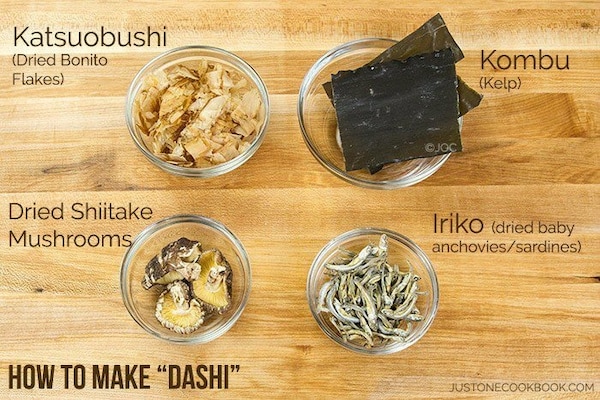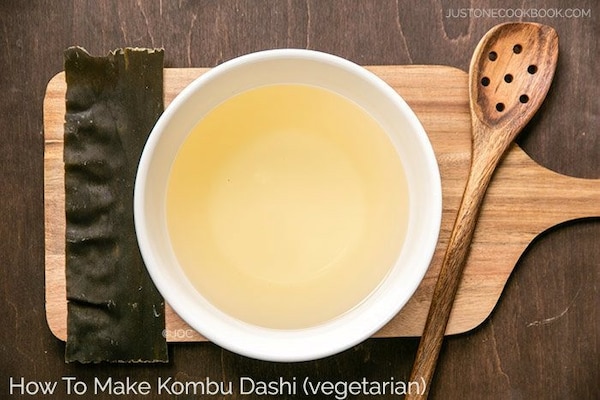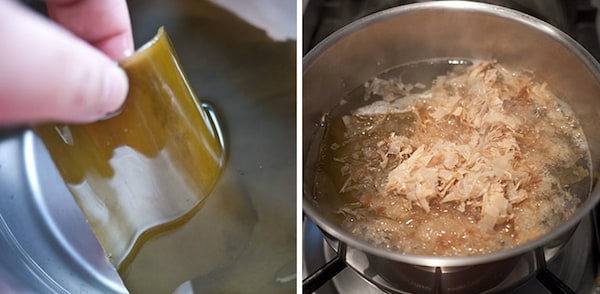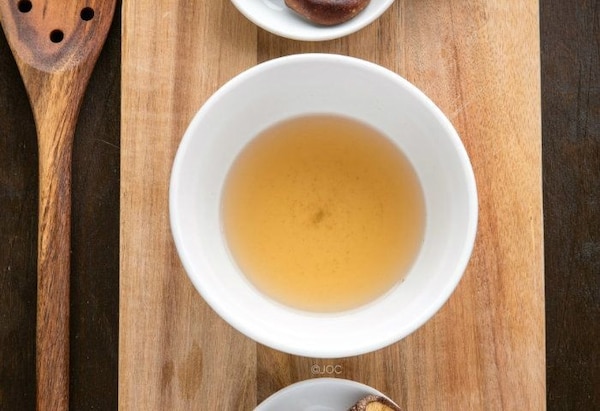How to Make 4 Key Kinds of Dashi

http://www.justonecookbook.com/how_to/how-to-make-dashi-jiru/
Dashi is also an element of donburi (rice bowl) dishes such as oyakodon, as well as various noodle dishes, hot-pots, chawanmushi, and certain kinds of rice. It's made from kombu (dried kelp, also spelled konbu), bonito flakes (dried and smoked skipjack tuna that's shaved into thin flakes, known in Japanese as katsuobushi), dried sardines (iriko or niboshi), or a combination of all or two of these elements.
Dashi is actually very simple to make, requiring about 20 to 30 minutes and only a handful of ingredients (often just one or two!). Nami at Just One Cookbook has compiled ways to prepare a number of these options, and we've assembled them below!
1. Awase Dashi
https://www.youtube.com/watch?v=qIWDxfCHQgs
Awase dashi is the most common, seafood-based stock. It's a combination of kombu and bonito flakes (katsuobushi). In this case, kombu dashi forms the base, while the stock is enriched by adding smoked bonito flakes.
This is basically an all-purpose stock that goes well with most Japanese recipes. While the preparation style might differ slightly from family to family or from restaurant to restaurant, the basic principles are pretty much the same. If you want a shortlist of the ingredients and instructions, check the recipe page below!
Read full story: www.justonecookbook.com
2. Kombu Dashi

http://www.justonecookbook.com/how-to-make-kombu-dashi-vegetarian-dashi/
This is the vegetarian version of standard dashi. Another option is shiitake dashi, which you can see below.
Kombu dashi takes a total of about 30 minutes to prepare. All you need is about 20 grams (0.7 oz) of kombu, 4 cups of water, a sieve and a paper towel. Read the full recipe below!
Read full story: www.justonecookbook.com
3. Shiitake Dashi
https://www.youtube.com/watch?v=4IAj6Euwin4
This vegetarian dashi is created by re-hydrating dried shiitake mushrooms (a common ingredient in Japanese cuisine) in water. Nami offers advice on how to get the best flavor from your dried shiitake, as well as step-by-step instructions, on her website below.
Read full story: www.justonecookbook.com
4. Iriko Dashi
https://www.youtube.com/watch?v=droK6yrrfdE
Iriko Dashi is most commonly used for making miso soup, since the strong miso flavor goes well with the aroma of fish—though the final taste isn't fishy at all. Another reason for the choice of iriko dashi for miso soup is that dried iriko tends to be cheaper than katsuobushi or kombu. Considering how much miso soup Japanese people consume, price is a pretty important factor!
Read full story: www.justonecookbook.com
Ichiban Dashi vs. Niban Dashi

http://justhungry.com/handbook/cooking-courses/japanese-cooking-101-lesson-1-its-all-about-dashi
Ichiban (first) dashi is made from previously unused kombu and katsuobushi. Niban (second) dashi is made from base ingredients that have previously been used for making ichiban dashi.
Why the distinction? Ichiban dashi is used for things like soups, when you want toget the maximum amount of umami possible from your ingredients. Niban dashi is used for things like stewed dishes, when other ingredients like meat and vegetables will add umami of their own, so a subtler dashi will suffice. Basically, niban dashi is a way of being frugal with your ingredients!
Want to know more? Check out the details at Just Hungry below!
Read full story: justhungry.com
Dashi Shortcuts
https://www.youtube.com/watch?time_continue=16&v=5qBAcsM31Rg
While making your dashi from scratch is undoubtedly the tastiest option, Nami at Just One Cookbook also has advice on dashi hacks, including using a dashi packet you can buy on Amazon, or instant dashi powder (also available on Amazon). It's all pretty easy, but the video above can serve as a great walk-through in case you're unsure!
Read full story: www.justonecookbook.com
What to Use When

http://www.justonecookbook.com/shiitake-dashi/
So when should you use each type of dashi? There's no hard-and-fast rule, but Nami offers a few examples of recommended dishes to go with each type below!
Read full story: www.justonecookbook.com




